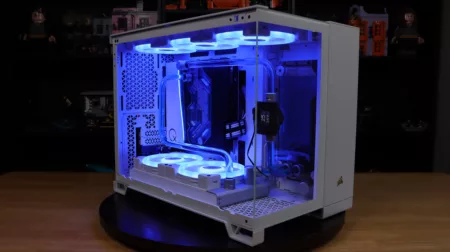Ladies and gentlemen, today we’ll be serving you up with our review of the Intel Core i7 2600K Sandy Bridge processor. We get on the driver’s seat and see what’s all the hype about as we take Intel’s LGA1155 flagship processor for a ride. Let’s make this showy!
The desktop processor market opened this year with a bang with Intel dropping the Sandy Bridge platform and the new offering instantly impressed everyone. With a highly efficient per-core performance, early benchmarks have shown the Sandy Bridge processors to be a worthy upgrade. Much to Intel’s dismay, a bug on the Cougar Point chipset was discovered a couple of months after the release of Sandy Bridge which resulted in a global recall of the affected motherboards. Though technically large-scale, this has been a minor setback to what would be a successful product from Intel.
Today we’ll be reviewing the flagship of the Sandy Bridge platform: the Core i7 2600K. The K is standard designation for Intel’s unlocked processors which make overclocking easier, thus performance boost galore. We’ll detail this later in the Overclocking section.
Here’s a quick spec of the Sandy Bridge Core i7 2600K:
| Processor | Core i7 |
| Model | 2600K |
| Price | around Php13900 – 15000 |
| TDP | 95W |
| Cores / Threads |
4/8 |
| Stock Frequency (GHz) |
3.4 |
| Turbo Frequency (GHz) | 3.8 |
| DDR3 Support |
1333 MHz |
| L3 Cache | 8MB |
| Intel HD Graphics | 3000 |
| GPU Max Frequency | 1350 MHz |
| Hyper-Threading | Yes |
| Socket | LGA 1155 |
PRODUCT GALLERY
Processor
To those keen observers, yes we have an engineering sample given to us for review. In Q3 2011. We get it. Its LATE. Retails are everywhere. The LGA1155 socket is not compatible with LGA1156 Nehalem processors even though the two bear a similar retention mechanism and allocation for cooling solutions meaning you can pop in your old Socket 1156 aftermarket cooler and still use it on 1155 motherboards so long as they can handle your intended processor.
Motherboard
Our review sample also came with Intel’s own P67 motherboard offering: the DP67BG. It doesn’t have the B3 designation as this board is also a evaluation model. Same goes for the BIOS. Those not familiar with the motherboard market might not recognize Intel as an immediate vendor when it comes to boards but Intel have shown their persistence in the desktop motherboard market. This particular board follows-up on the enthusiast oriented X58 Skull-trail motherboard and the skull logo is carried over to this board also.
TEST SETUP
Hardware
Intel DP67BG with Core i7 2600K with stock heatsink-fan
Inno3D GeForce GTX570
2x4GB DDR3 1333 MHz CAS9 Corsair Value Select
Thermaltake Litepower 700W
LG E2350V – 1920×1080
Software
Windows 7 Ultimate Edition 32-bit
GeForce 275.33 Driver
PERFORMANCE TESTING
Note: Since this is a new part of our site, our processor benchmark list are still few. We’ll build them up over time so for now, we’ve left some tests dedicated to the review subject.
We’ll start off with SiSoft’s SANDRA CPU Benchmarks which includes the Dhrystone and Whetstone tests. These tests basically all run within the CPU and cache so it is really a test to show how a processor performs.
First up the Dhrystone, which is a integer and string benchmark.
The other processors are there for comparison and we’ve included Intel’s former LGA1366 flagship, Core i7 980X. As you can see the 2600K is well up there with its much more expensive big brother.
In the Whetstone benchmark, which measures floating point arithmetic performance, we see good numbers being put up as well.
Now we move on towards test with SuperPI and wPrime. SuperPI is single-threaded so our results show the performance of a single core.
For those not familiar, lower numbers means quicker calculations which is a good thing and as evident in the chart the 2600K really puts up good numbers on single threaded performance.
We’ve handicapped the 2600K a bit here by only utilizing 4 threads. Still it manages to put a beatdown on the similarly clocked Phenom X4 B55. And just for kicks we’ve OC’d the 2600K (more on that later) and included the results.
Maxon offers a nice benchmark tool called Cinebench which really stresses your entire system to render a very complex scene.
Cinebench is pretty taxing on the system. As seen on our chart, the 2600K gained a massive boost when OC’d to 4.8Ghz. But the stock results are around 200% better than the similarly clocked B55.
Video conversion is one major requirements of user which requires heavy processing power. We used Xilisoft and conver a 150MB 1080p clip into x264 format and average out the times we get in 3 runs.
GAME TESTING
But games are GPU-dependent! Yeah we know, still a good CPU won’t cause bottlenecks that might plague that expensive video card of yours. We test our benchmarking unit in a couple of run of Crysis 2 and see what we get.
That’s maxed out settings at 1920×1080. We’re getting good frame rates here and there but the GTX570 can only go so far unfortunately we didn’t have the DX11 update for Crysis 2 for testing. We’ll check back on that on future reviews.
Closing out our tests we have 3DMark Vantage to benchmark our system.
OVERCLOCKING
Okay so overclocking the new Sandy Bridge processors are a bit of a challenge. Since the a GPU resides within the same die and run on the same bus, you’d be lucky if you can lift that base clock upwards of 115Mhz. Intel was nice enough to release K versions of their processors like what we have today which have unlocked CPU multipliers meaning you can take your processor further more by just adjusting the multi and not touching the base clock.
We overclock our review sample using the stock cooler to see how far we can take it straight out of the box. We used Intel’s Extreme Tuning Utility to tweak our settings.
We were able to bring our system to a final stable overclock of 4.8Ghz but temperatures were not very nice. We concluded that our processor is from a hot batch since we’ve tried changing TIM and reseating the HSF numerous times with no positive results. Taking it further we were able to reach 5Ghz but the temperatures have proven too high, still we took a screenshot just for kicks. And no we didn’t burn our proc.
The Intel stock heatsink did a pretty good job cooling this beast in stock temps (even with our hot sample) and a nice choice from Intel. Contrary to your typical stock HSF from Intel, the 2600K comes with a tower-type heatsink with heatpipes and a single fan with a fan speed controller.
Â
CONCLUSION
Right from the start we were expecting great things from the 2600K and boy did it blew away our expectations. We can say a lot of things about the Core i7 2600K but there’s just too much to mention so we’ll just mention the important ones. First, the Core i7 2600K is one major leap from the old 1156 processors. The improved core performance is simply astonishing and its efficiency is simply to die for.
From power consumption, temperatures to performance. Everything is well up there and quite frankly Intel has given its LGA1366 beasts a run for their money and speaking of money, that’s where everything boils down to. The Core i7 2600K is well positioned price-wise in the local market and gaming-wise you’re really not gonna get anything better that will reap you any benefits.
So it worth forking out for this baby? We say yes. Forking out a bit extra over the i7 2600 will get you monster overclocking capabilities and a nice performance boost if you have a decent aftermarket cooler. In closing, if you’re looking for a high-end desktop processor that can crunch numbers fast for professional work or just want to have the current swag gear in the processor market, then this is for you but right now better hold on to your money because Bulldozer is right around the corner. If you’re creating a new rig, better wait till Bulldozer drops and go head to head against Sandy Bridge. But if you need the processing power and don’t want to go to LGA1366 territory, then the Sandy Bridge Core i7 is your choice.
Intel has collaborated with SM Entertainment to promote the Sandy Bridge Core i-series in South Korea. And as a very big SNSD fan, I would love to have a Core i9 please. Name it Taeyeon, too. DO IT, Intel.





